Abstract
I HAVE recently had occasion to consider the problem of constructing a simple standard source of sound, and have been favourably impressed by the possibility of employing a “hot wire” grid—as used in the Tucker microphone (Phil. Trans. A, vol. 221, pp. 389–430)—for this purpose. In this microphone the grid is made of fine platinum wire and heated by a current of 20–30 milliamperes. It is mounted in the orifice of a Helmholtz resonator, and when the latter is stimulated by a sound of suitable pitch, the vibration of the air in the orifice causes an increase in the average rate of loss of heat by convection, and consequently there is a fall in the temperature, and hence in the resistance, of the grid. The fall in resistance can be measured by a Wheatstone bridge method. The way in which it is suggested that this process may be utilised in the construction of a standard source of sound is as follows. The source is made in the form of a cylindrical Helmholtz resonator—say from brass tubing about 2 in. diameter. At one end is fitted a telephone in such a way that the diaphragm forms part of the inner wall of the resonator, while at the other end is the orifice carrying the hot-wire grid. If the telephone diaphragm is made to vibrate by current from a thermionic valve oscillator, and the frequency of the current is adjusted until it is equal or nearly equal to that of the resonator, a pure tone of moderate intensity issues from the orifice. At the same time the hot-wire grid suffers a change of resistance which provides a measure of the amplitude of the vibration in the orifice, and hence of the strength of the source. With a standard pattern grid and holder the change in resistance is about 12 ohms when a sound of pitch 200 vibrations/sec. is produced, which is loud enough to be just audible at a distance of 10 feet—the source being placed on the ground in the open. The strength of the source can be varied at will by using a variable series resistance or a shunt with the telephone. The use of resonance serves to purify the note which comes from the telephone, but it is desirable in addition that the oscillator should be of such a type that the telephone note is already fairly pure. The use of a very impure note may lead to poor results, as the resistance change will then depend only partly on the amplitude of the fundamental.
Similar content being viewed by others
Author information
Authors and Affiliations
Rights and permissions
About this article
Cite this article
PARIS, E. The Production of a Standard Source of Sound. Nature 110, 378–379 (1922). https://doi.org/10.1038/110378b0
Issue Date:
DOI: https://doi.org/10.1038/110378b0
- Springer Nature Limited




